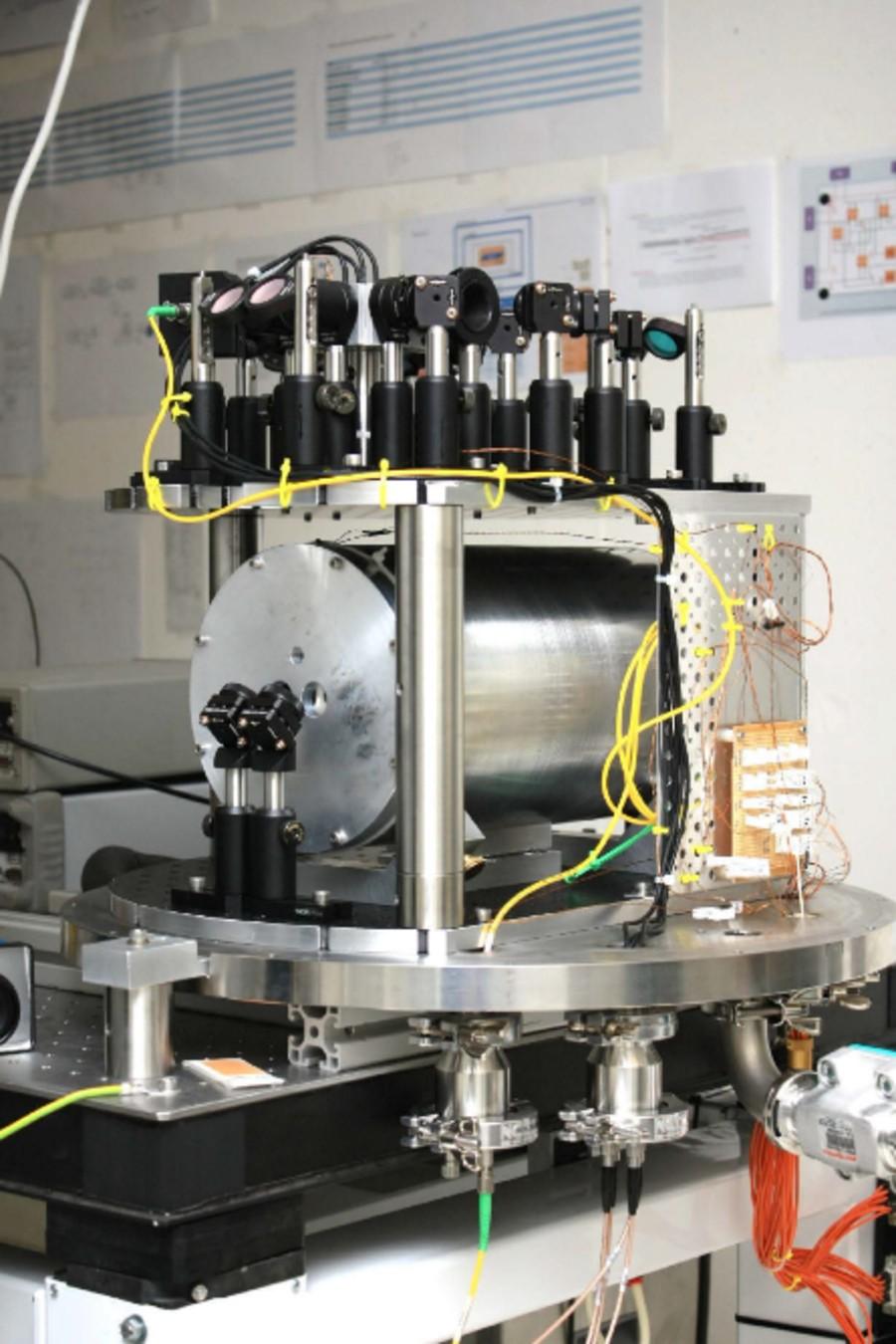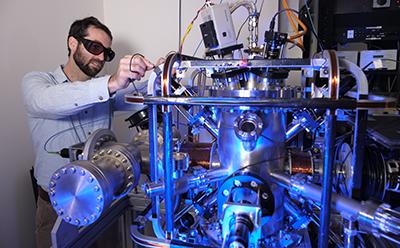Sensing and Spectroscopy
The optical frequency comb is a Nobel Prize winning innovation in laser technology that is revolutionising spectroscopy. We use this massively parallel laser source to characterise atomic and molecular samples with unprecedented precision, accuracy, and speed.
We also specialise in precision laser absorption and two-photon spectroscopy, both within conventional cells and fibre based architectures, with applications in fundamental physics, frequency standard development, quantum computing, and all-optical atomic magnetometers for high sensitivity magnetometry.
-
Optical Breath Analysis
The exhaled breath is a rich source of information about the inner life of the human body - but untangling this complicated molecular mixture into a quantitative measurement of its constituent components is currently an unsolved problem. We are developing a new instrument that leverages the Nobel Prize winning technology of the optical frequency comb to enable analysis of such mixtures.
The optical frequency comb is essentially a massively parallel laser source with millions of individual laser signals equally spaced across the optical spectrum. By combining a frequency comb source with an innovative parallel detector and a highly sensitive sampling system, we can generate a real-time spectral signature of the sample. Computational techniques developed by the radio astronomy community will then be used to extract concentrations of individual molecular components at the parts-per-billion level.For more information, contact Dr Chris Perrella and Dr Sarah Scholten.
- Scholten, S. K. et al, Phys. Rev. Appl. 12, 034045 (2019), 10.1103/PhysRevApplied.12.034045
- Scholten, S. K. et al, Phys. Rev. Appl., 9, 054043 (2018), 10.1103/PhysRevApplied.9.054043
- Scholten, S. K. et al, Opt. Lett., 41, 1277 (2016), 10.1364/OL.41.001277
- Bourbeau Hébert, N. et al, Opt. Express, 23, 13991 (2015), 10.1364/OE.23.013991
-
Real-Time Contaminant Monitoring in Liquid Natural Gas Processing
Solid formation in key liquid natural gas processing steps costs an estimated $500 million in lost production annually. Characterising the concentration of heavy hydrocarbons (which act as nucleation sites) is key to avoiding costly shutdowns whilst operating at economically viable temperatures.
We are developing an instrument for real-time analysis of the concentration of these heavy hydrocarbons based on massively parallel absorption spectroscopy using an optical frequency comb.For more information, contact Dr Chris Perrella and Dr Sarah Scholten.
-
High Precision Atomic Magnetometry
Detection of small deviations in magnetic field is extremely useful in many applications, including: medical, for detection of fluctuating magnetic fields in the heart or brain; defence, for passive detection of submarines; and geology, for geomagnetic surveys. We are developing small, all optical, atomic magnetometers based on the Non-linear Magneto-Optical Rotation (NMOR) technique. By using an appropriately tuned and modulated laser it is possible to sample the Larmor frequency of a collection of atoms, which, in turn, is determined by the local magnetic field. These magnetometers have demonstrated sensitivity at the femtoTesla level, which compares very well with current technologies. In addition, these sensors can be easily miniaturised and fibre coupled, making it an extremely convenient platform for application in the field.
For more information, contact Dr Chris Perrella.
- Wilson, N., Light, P., Luiten, A. & Perrella, C. Phys. Rev. Appl. 11, 044034 (2019), 10.1103/PhysRevApplied.11.044034.
- Wilson, N. et al. Phys. Rev. Appl. 10, 034012 (2018), 10.1103/PhysRevApplied.10.034012
-
Primary Thermometry

The International System of Units (SI) system is an extremely successful coherent framework for describing the physical world. At its heart are seven base units, from which all others are derived. Recently four of these, including the Kelvin, were redefined such that all base units are now defined in terms of fundamental constants. This has removed the need for physical artefacts in the definition of the units.
The Kelvin has been defined as “the change of thermodynamic temperature that results in a change of thermal energy kbT by 1.380649×10–23J”. This means that through a measurement of the thermal energy, temperature can be determined via the exactly defined Boltzmann constant.
It is desirable to have a systematic, easily replicable determination process for realising these units anywhere in the world. This project is aimed at fulfilling this for the Kelvin by developing a determination process based on atomic caesium gas. Atomic gases in thermal equilibrium exhibit the well-known Maxwell-Boltzmann velocity distribution. When interrogated at a suitable transition by a sufficiently pure laser source, the width of the resulting Doppler-broadened lineshape is related to the true, thermodynamic temperature of the caesium gas.
Our current system is capable of a thermal energy determination with 6ppm precision and uncertainty of 71ppm. We are currently improving several aspects of the system, primarily the purity of the laser source, in order to be able to make measurements with uncertainty comparable to or better than other techniques.
A particular benefit of our Doppler-broadened thermometry technique is the potential to make accurate temperature measurements over large temperature ranges.
For more information, contact Dr Phil Light.
- Truong et al., “Accurate lineshape spectroscopy and the Boltzmann constant,” Nature Comms. 6 8345 (2015)
-
Atom Trap Trace Analysis

Measuring the ultra-low concentrations of these radioactive noble gases allows researchers to understand the age, origin and interconnectivity of the groundwater and how it has moved underground through space and time. This is the first Atom Trap Trace Analysis facility in the Southern Hemisphere and, combined with our partner CSIRO’s complementary Noble Gas Facility at the Waite campus in Adelaide, gives Australia one of the most comprehensive noble gas analysis capabilities in the world.
Australia relies on its groundwater for 30% of its water supply for human consumption, stock watering, irrigation and mining. With climate change and periods of prolonged drought, surface water is becoming increasingly more unreliable and the use of groundwater is rising. We need to make sure it’s sustainable.
Because noble gases don’t easily react chemically, they are the gold standard for environmental tracers to track groundwater movements. Before this new facility, researchers wanting to measure these ultra-low concentrations of noble gases had to rely on a very small number of overseas laboratories which can’t meet demand for their services.
ATTA’s analytic capability will also allow researchers to look further into the past of Antarctica’s climate, building understanding of global environmental change. This allows us to understand the sources of water, where it comes from and what the recharge rates are, which then allows us to make decisions about sustainable extraction. This is critical where development of any kind might use or impact groundwater systems – from urban development where groundwater systems are used to supply communities, to agricultural and mining development.
Energy, mining and resources is a key industry engagement priority for IPAS and the University of Adelaide and environmental sustainability is a research focus.For more information, contact Dr Phil Light and Dr Rohan Glover.
A video explaining the facility can be seen here.
